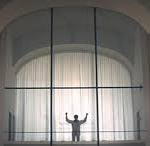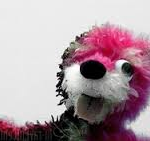In college, I was convinced that symbolism would be my downfall. I’d never graduate. It all started in high school when I was a new sophomore in an all-girls boarding school. Mr. Shohet, my English teacher, seemed like an aggressive, angry sort, perhaps a frustrated author who resented having to teach callow over-privileged teenagers. He would sit back in his chair with his hands behind his head and then suddenly lean forward and pith me with a piercing stare and probing question.
My prior English teachers had all been demure widows or spinsters who focused on such things as diagramming sentences to emphasize the faux pas of a dangling modifier. Book reports were merely plot summaries with the emphasis on what the author said, not what he meant. Critical thinking was simply not part of the curriculum. Now with Mr. Shohet I was supposed to participate in class discussions about deeper meanings and symbolism, to come up with some analysis and then defend it in front of the class. I sensed that my roots in the Chicago suburbs were no match for my East coast classmates from places like Park Avenue, which I knew from the expensive cobalt blue square on the Monopoly board. I had heard of their fancy hometowns – Greenwich or New Canaan – but my classmates had never heard of my town of Lake Forest. I always tried to sit unobtrusively in the back row, anxiously watching the clock to see if I could escape another English class without being called on. When the bell rang, I eagerly skipped down the hall to the friendly confines of my math class.
How I loved my geometry, all about proofs and unassailable logic. The only symbols were the math notations of the plus, minus, multiplication, division, and X’s for unknown quantities. If anyone challenged my proof, I could simply push my diagram across the table. I didn’t need to wonder about the hidden meaning of an equation and I didn’t have to defend my ideas. Case closed, no discussion needed. Sometimes even the proof itself was irrelevant; it was the elegance or cleverness of how I proved a theory, such as the formula for the area of a triangle. Perhaps I could create a proof more efficiently – shave off one of the steps illustrated in the textbook. After all, there are over 300 proofs of the Pythagorean theorem about right triangles – maybe I could win great acclaim by devising yet another proof.
But the next day, there I was again in English. “Okay class, listen to this poem,” said Mr. Shohet. “It’s a famous one by William Carlos Williams.”
so much depends
upon
a red wheel
barrow
glazed with rain
water
beside the white
chickens
“What do you think of the symbolism of the chicken and the red wheelbarrow?” asked Mr. Shohet. “Why did he say so much depended on them?”
 “Oh good Lord,” I thought to myself, “How the hell am I supposed to know? I don’t know why the wheelbarrow is red, perhaps the farmer had extra red paint after fixing up his barn. The white chicken? We used to have chickens in our back yard. Let’s see, they came in all colors, but we mostly had white ones because they were the best layers. Maybe that’s the reason.”
“Oh good Lord,” I thought to myself, “How the hell am I supposed to know? I don’t know why the wheelbarrow is red, perhaps the farmer had extra red paint after fixing up his barn. The white chicken? We used to have chickens in our back yard. Let’s see, they came in all colors, but we mostly had white ones because they were the best layers. Maybe that’s the reason.”
I kept quiet. I knew my answer was entirely inadequate compared to one of the more worldly New Yorkers who commented on the brilliant choice of the word glazed. “I think that glazed suggests the passage of time,” she said. “A few minutes ago the wheelbarrow would have been wet because it was still raining, but if it’s glazed, the sun must be shining now. So the wheelbarrow represents that moment of time between wetness and dryness. See what I mean? The glazing is the present tense that represents the division between before and after. Yeah, I mean so much depends on that.”
(Please note that I have not peppered this remembered conversation with the word “like” – the reflexive and continual use of this word had not yet infiltrated 1960s dialogue.)
“I’m thinking that the wheel barrow might be a religious symbol,” said another student. “After all it has only three legs – couldn’t it be the holy trinity?” Mr. Shohet nodded appreciatively. In my corner I tried to shrivel into a non-entity.
I had not yet said a word all semester when the discussion turned to the recent movie The Graduate. I think Mr. Shohet felt that he was lobbing me a gimmee when he turned to me and said, “Bobbie, what did you think of the end of the movie when Benjamin Braddock is standing in the nave above the church? Remember his arms are outstretched and he is banging on the window to interrupt the wedding ceremony.”
 I knew that it had to be something religious, even I could see that Benjamin was a Christ figure with his arms outstretched – in a church no less – but I could not come up with a reasonable explanation. I erupted in flop sweat as I scrambled for some sort of pithy response. Was this a satire on church, marriage, did Benjamin feel that he was being sacrificed on a plastic cross of wealth and ambition? I absolutely froze. I distinctly remember my shame in saying, “I don’t know about the church but I liked the Simon and Garfunkel music in the movie.” That was the best that I could come up with. I continued to hide in English class for the rest of high school. In my junior year, my English teacher wrote that I was bored and hostile, but the real issue was that Mrs. Harvey just wasn’t able to recognize cowering fear.
I knew that it had to be something religious, even I could see that Benjamin was a Christ figure with his arms outstretched – in a church no less – but I could not come up with a reasonable explanation. I erupted in flop sweat as I scrambled for some sort of pithy response. Was this a satire on church, marriage, did Benjamin feel that he was being sacrificed on a plastic cross of wealth and ambition? I absolutely froze. I distinctly remember my shame in saying, “I don’t know about the church but I liked the Simon and Garfunkel music in the movie.” That was the best that I could come up with. I continued to hide in English class for the rest of high school. In my junior year, my English teacher wrote that I was bored and hostile, but the real issue was that Mrs. Harvey just wasn’t able to recognize cowering fear.
In college I gravitated to science courses as I prepared for medical school. However, English 101 was a requirement for graduation. So there I was in my last semester of college, feeling like a senior citizen as I stood in the registration line with jabbering freshman. Due to the size of this introductory class, students were randomly assigned to individual professors who set their own curriculum. The next day I was horrified to see that I had been assigned to a poetry section. This was it. I could avoid it no longer. Time to suck it up and wade into the shadowy world of symbolism.
My professor was a fan of Yeats, a Nobel prize-winning English poet famous for using symbolism to express two opposing forces of nature. With that little clue, I tried to invent as many symbols as I could. I just let it rip. I opined that roses could represent the tension between beauty and inevitable decay, stones could symbolize either reliability or obstinacy, and water, well what the hell, I cribbed off of the glazed wheelbarrow. With solid, liquid and gas forms, I wrote that good old H2O could somehow symbolize the transition from past to present to future. I aced the class and was relieved to get my diploma. However, the whole exercise was confusing. I felt like a fraud. After all I had just made everything up. There was no proof.
After this final college triumph, I entered the strictly symbolism-free world of medical school. Ah, the particular pleasure of sitting down with a good textbook and the soothing aroma of a fresh neon highlighter. My very limited leisure reading focused on non-fiction, with an emphasis on military history – The Rise and Fall of the Third Reich, The Collapse of the Third Republic, The Proud Tower were all checked off my reading list. I appreciated those authors who could synthesize masses of information into readable and informative accounts, skills that I would later need in my career as a medical writer.
I didn’t come face to face with symbolism again until I started binge-watching the TV show Breaking Bad with my friend Sallie, an English major whose right brain is a coiled treasure of creativity and imagination. Sallie ripped off symbols right and left as I sat transfixed watching Walter White, a high school chemistry teacher, turn to cooking meth to support his family. I was into the plot line, Sallie into symbolism. “Bobs, Bobs, look at the pattern of those window blinds, Bobs, did you see that color, do you think green shirt is a symbol for envy or for rejuvenation, how about that tarantula trapped in a glass, what do you think that means?”
Fortunately, Sallie is much less intimidating than Mr. Shohet and I started to watch Breaking Bad with a newly critical eye. There was one recurring image of a charred, one-eyed pink teddy bear floating in Walter’s back yard pool. We eventually learned that the toy was a piece of falling debris from an overhead mid-air collision. Walt eventually finds the missing eye in the swimming pool scupper and keeps it. Certainly, there are a lot of ways you can go with this – you’ve got the falling from the sky, you’ve got the symbol-rich eyeball, the charring, the color pink, the symbolic drowning in the pool, on and on.
 I reverted back to my high school question of “Forget about me, what did the author mean to say?” Here is what Vince Gilligan, creator of Breaking Bad, has to say about the famous pink teddy bear:
I reverted back to my high school question of “Forget about me, what did the author mean to say?” Here is what Vince Gilligan, creator of Breaking Bad, has to say about the famous pink teddy bear:
“The teddy bear eyeball that Walt found in his swimming pool is symbolic. It’s very, very symbolic. However, I’m not sure I can tell you with 100% certainty of what the symbolism is, what it represents… but I’m always interested in hearing what it means to viewers of the show.”
In another interview:
“Your appreciation of the show doesn’t in any way rely on noticing these things. But they are there to be noticed, nonetheless, which is up to the viewer to pick up on it or not.”
Are you kidding me? The author doesn’t even understand his own symbols? It’s up to me? Okay, I get it. Yes I can appreciate the story line of Breaking Bad without the symbols, but perhaps I can have a deeper experience if I seek a more active role in the triangle of reader, author and story. However, I’ve got to say that this sounds like a parlor game, and I’m not alone. Judging from internet traffic, aficionados have spent hours repeatedly watching episodes to find and decipher Vince Gilligan’s hidden symbols.
I was willing to give this game a try, but I needed a few more ground rules to help me along. I extracted the following workable tips on symbolism from the book “How to Read Literature Like a Professor,” by Thomas Foster:
1. If it’s longer than it is wide, it might be a phallic symbol
2. If it’s a swimming pool, think womb or alternatively isolation and drowning. (see The Graduate for examples.)
3. Any kinds of stripes (window slats, staircase), think prison
4. Food often has a sexual context, particularly when someone is gnawing and sucking on ribs (think Tom Jones).
5. It would be helpful to have a working knowledge of the Bible, Shakespeare and Greek mythology, since plot lines tend to repeat themselves.
6. Rain is often transformative or cleansing, but probably not if it’s associated with mud. Fog symbolizes confusion, snow can really be anything.
7. A car ride or any kind of trip is usually something more – a quest for self-knowledge is a popular theme.
8. Always notice colors (see Internet for extensive discussion of colors in Breaking Bad)
Okay, now I’m ready to play. My first effort will be the analysis of the symbolism in “A Whiter Shade of Pale,” the iconic 1967 song by the English band Procul Harem. This is my all time favorite song from my high school days, in part based on the introductory hook of the haunting organ solo. I have always loved the mood and the melody, but never understood the lyrics. Now I’m up for the challenge.
We skipped the light fandango
Turned cartwheels cross the floor
I was feeling kinda seasick
But the crowd called out for more
The room was humming harder
As the ceiling flew away
When we called out for another drink
The waiter brought a tray
[Chorus]
And so it was that later
As the miller told his tale
That her face, at first just ghostly,
Turned a whiter shade of pale
She said, there is no reason
And the truth is plain to see.
But I wandered through my playing cards
And would not let her be
One of sixteen vestal virgins
Who were leaving for the coast
And although my eyes were open
They might have just as well’ve been closed
And so it was that later
As the miller told his tale
That her face, at first just ghostly,
Turned a whiter shade of pale
I can’t quite fit all the images in, but my best guess is that this the story of two people in a relationship. The first verse is from the viewpoint of the woman, a vestal virgin who is working hard to maintain her vow of chastity. Unfortunately, I think that she might have “roofied” in the bar, hence the symbols of the cartwheels, humming and fly-away ceiling. The second complete verse is from the point of view of the man. Here is my major insight – the two italicized lines should be read as a single sentence, i.e. the man would not let her be a virgin. Now it becomes clear. The man rapes her and then drowns her at the coast. The chorus is the cautionary tale told by the miller. Internet chatter suggest that the miller represents on of Chaucer’s story tellers, but I have a better idea. A miller symbolizes a person who separates the wheat from the chaff and finds the essential truth. He describes the woman’s face as all life slips away and she slowly drifts off, her image distorted and ghostly under the warping water.
As compelling as this analysis might be, my second interpretation is that this is a delusional mess from a drug-addled lyricist.
The internet offers many other interpretations, and I was interested in the singer Annie Lennox’s version, as depicted by her music video. She creates a circus-themed montage with horses, clowns, jugglers, trapeze artists, and women in tutus. Based on this video, I would like to add another symbol to Foster’s symbolism cheat sheet. An resplendent glistening white horse, confirmed to be male on careful stop-action viewing, most certainly must be a sexual symbol.
 So Annie’s got her opinion, I’ve got mine and I am newly comfortable with competing neither right nor wrong analyses. Nevertheless, I am ready to reach for the book at my bedside table, The History of the Tank.
So Annie’s got her opinion, I’ve got mine and I am newly comfortable with competing neither right nor wrong analyses. Nevertheless, I am ready to reach for the book at my bedside table, The History of the Tank.
The missing words in the following poem are anagrams (i.e. share the same letters like spot, post, stop) and the number of asterisks indicates the number of letters. Your job is to solve the missing words based on the above rules and the context of the poem. Scroll down for answers.
If you want to decipher symbols like a literary genius
Get ready because everything will start to look like a *****.
That ramrod straight ***** that extends from your hips to your neck,
Ask yourself, is it longer than it is wide? CHECK!
You might think that ***** is a verb, but let me introduce you to the bird,
 If you are in the symbolism groove, your brain will say the p-word.
If you are in the symbolism groove, your brain will say the p-word.
Yes graceful ***** gently sway when the wind is breezy
By now you know my point, so finding the symbol is easy.
*
*
*
*
*
*
*
Answers: penis, spine, snipe, pines
Follow Liza Blue on:Share:
